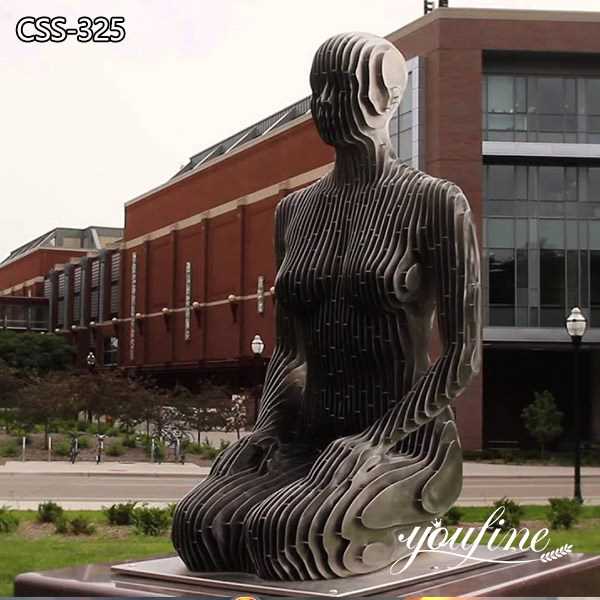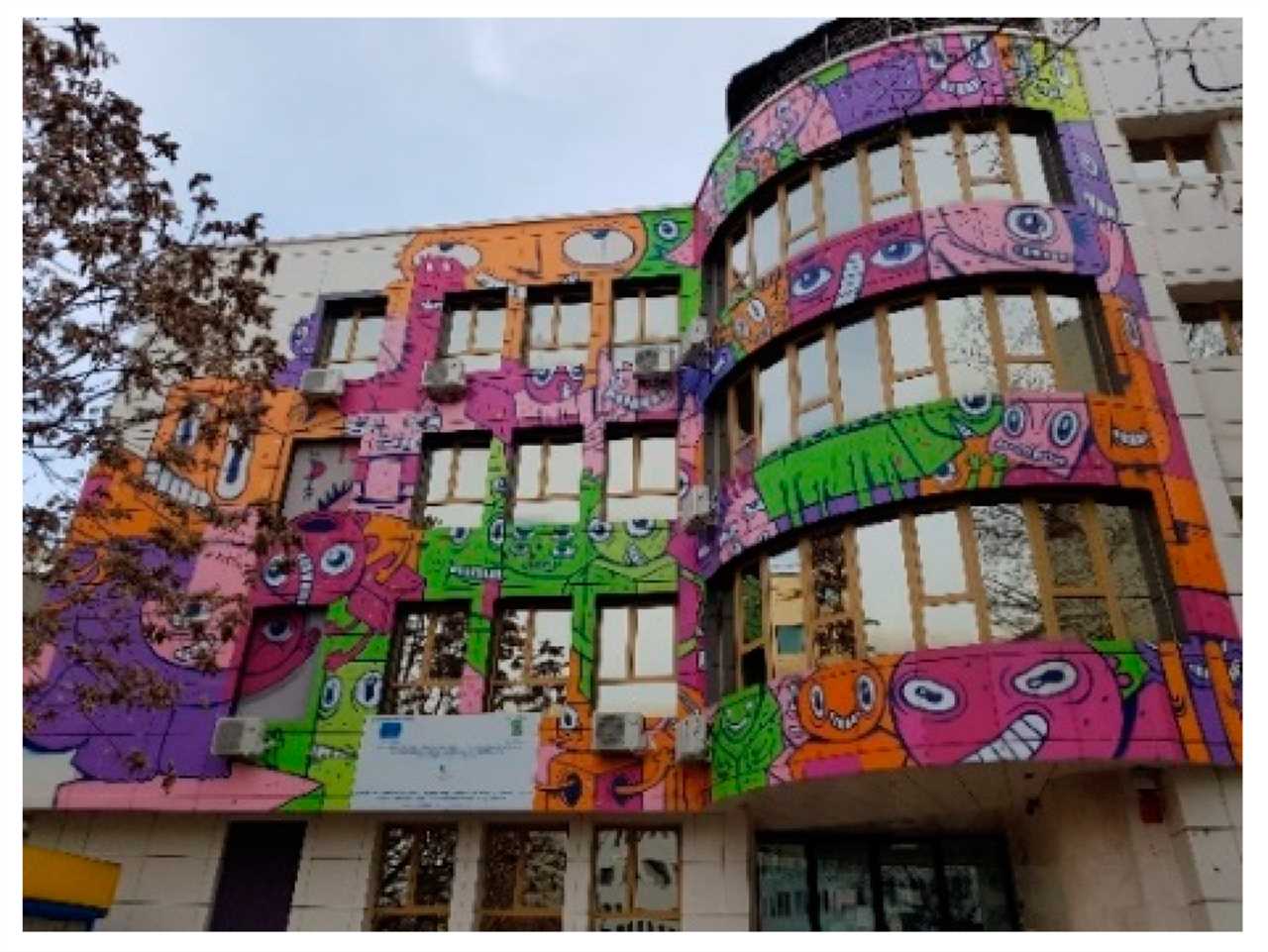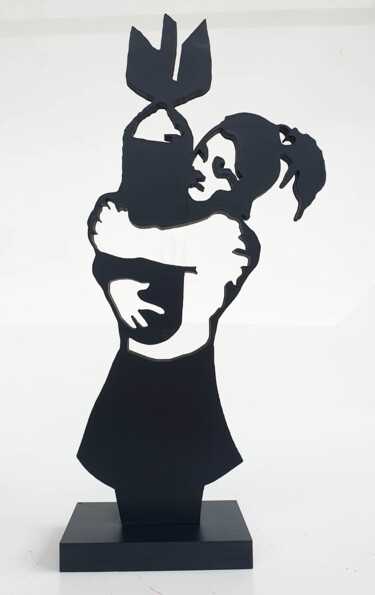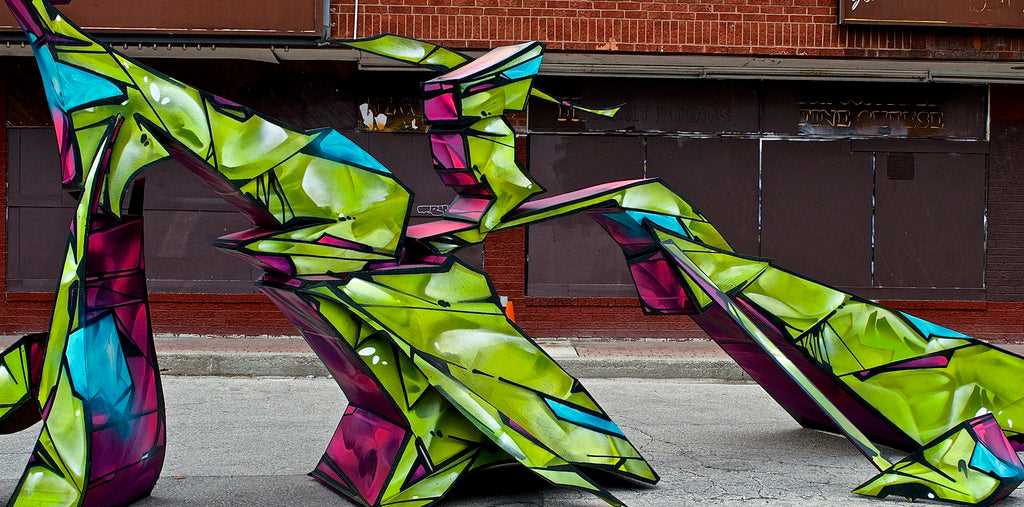
When you think of street art, graffiti might be the first thing that comes to mind. But in recent years, a new form of street art has emerged that combines the raw energy of graffiti with the permanence of sculpture. Sculpture street art is a dynamic blend of metal, concrete, and graffiti that takes urban art to a whole new level.
Unlike traditional sculptures that are displayed in galleries and museums, sculpture street art is accessible to everyone. It can be found in the most unexpected places – on walls, sidewalks, and even abandoned buildings. This form of art challenges the notion that sculptures should be static and unchanging. Instead, sculpture street art invites interaction and engagement from the viewer.
One of the most exciting aspects of sculpture street art is the use of unconventional materials. Artists often repurpose scrap metal, discarded objects, and concrete to create their masterpieces. This not only adds an element of sustainability to the art form, but also a sense of rawness and grit. The juxtaposition of these industrial materials with the vibrant colors and intricate details of graffiti creates a visually striking and thought-provoking experience.
The Emergence of Sculpture Street Art in Urban Landscapes
The combination of metal, concrete, and graffiti creates a vibrant and dynamic blend of artistic expression in urban landscapes. Sculpture street art has emerged as a powerful form of public art that transforms the traditional perception of sculpture and challenges the boundaries of urban aesthetics.
Redefining Traditional Sculpture
Traditionally, sculpture has been associated with permanent, static forms placed in designated areas such as parks or plazas. However, sculpture street art breaks away from these conventions by integrating elements of street culture and graffiti into the creation process.
Artists use metal and concrete to create three-dimensional structures that interact with their surroundings, immersing viewers in a unique visual experience. The incorporation of graffiti adds an urban twist, infusing the sculptures with color, texture, and a sense of rebellion.
A Dialogue with Urban Environment

Sculpture street art goes beyond mere decoration; it acts as a catalyst for dialogue between the artwork itself, the urban environment, and its inhabitants. These sculptures are often strategically placed in public spaces, inviting passersby to interact with and interpret the artwork in their own way.
The juxtaposition of the industrial materials used in sculpture street art against the urban landscape creates a visually stimulating contrast that challenges the perception of public spaces. It encourages viewers to question their surroundings and engage with the art on a deeper level.
| Benefits of Sculpture Street Art in Urban Landscapes |
|---|
| 1. Enhances the aesthetic appeal of urban areas, turning them into open-air galleries. |
| 2. Promotes cultural diversity and artistic expression within urban communities. |
| 3. Provides a platform for local artists to showcase their talents and engage with the public. |
| 4. Sparks conversations and interactions among residents and visitors. |
| 5. Creates a sense of identity and place-making within urban neighborhoods. |
The Intersection of Sculpture and Graffiti: An Unconventional Combination

Graffiti and sculpture are two distinct art forms that have been creating a buzz in the world of street art. While they may seem like polar opposites, their intersection has brought about an unconventional and dynamic blend that has captivated audiences around the world.
Whereas graffiti is known for its vibrant colors, bold lettering, and urban context, sculpture is often associated with durability, structure, and three-dimensional form. The merging of these two art forms may seem unlikely, but it has proven to be a match made in artistic heaven.
The Birth of an Artistic Fusion

The combination of sculpture and graffiti can be traced back to the early days of street art culture. Artists began experimenting with different materials and techniques, incorporating sculptural elements into their graffiti pieces. Metal rods, wires, and concrete became integral components, adding depth and texture to the traditionally flat graffiti surfaces.
As this fusion evolved, artists started to create full-scale sculptures that were adorned with graffiti. These works challenged the notion of what street art could be and pushed the boundaries of artistic expression. The combination of the two mediums allowed artists to create dynamic and interactive installations that engaged with the surrounding environment and the audience.
The Impact of Sculpture in Graffiti
Sculpture has had a profound impact on the graffiti world. It has introduced new dimensions, literally and figuratively, to the art form. The addition of sculptural elements has elevated graffiti from a two-dimensional image to a three-dimensional experience.
By integrating sculpture into their work, graffiti artists have been able to create pieces that have a physical presence and occupy space in a way that traditional graffiti cannot. This merging of mediums has added a new layer of depth and complexity to street art, further blurring the lines between vandalism and artistic expression.
The unconventional combination of sculpture and graffiti has opened up new possibilities for artists to explore and engage with their surroundings. It has challenged traditional notions of what is considered art and has given voice to a new generation of street artists who are breaking boundaries and redefining the urban landscape.
Materials and Techniques: Exploring Metal and Concrete in Street Art
Street art is a vibrant and dynamic form of artistic expression that often utilizes a wide range of materials to create visually striking and thought-provoking works. Two common materials used in street art are metal and concrete, each offering unique properties and possibilities for artists.
Metal

Metal sculptures are a common sight in street art, as the material’s durability and ability to withstand the elements make it an ideal choice for outdoor installations. Artists often create intricate designs by welding together various metal pieces, resulting in three-dimensional sculptures that can range in size from small and delicate to large and imposing.
One popular technique with metal is the use of found objects, where artists repurpose discarded items such as scrap metal, bike parts, or car pieces to create their sculptures. This approach gives the artwork a sense of repurposing and sustainability while also adding an element of surprise and intrigue for viewers.
Another technique is metal etching, where artists use chemicals or mechanical tools to create intricate designs or patterns on a metal surface. This technique allows for a great amount of detail and precision, giving metal sculptures a unique texture and visual appeal.
Concrete
Concrete is another commonly used material in street art, often used to create large-scale murals or sculptures. Its ability to be shaped and molded allows artists to create unique and expressive works with a solid and permanent presence.
One technique with concrete is stenciling, where artists create stencils of their desired designs and then use spray paint or other coloring methods to transfer those designs onto a concrete surface. This technique allows for precise and intricate details, making it popular among street artists who want to create realistic or finely detailed works.
Concrete can also be carved or sculpted directly, allowing artists to create three-dimensional sculptures that are seamlessly integrated into their respective surroundings. This technique often requires a high level of skill and precision, but the end result can be incredibly striking and visually captivating.
By using metal and concrete in street art, artists are able to create sculptures and murals that not only withstand the test of time but also add an element of texture, dimension, and permanence to the urban landscape. Whether it’s the intricate welding of metal or the precise stenciling on concrete, these materials and techniques allow for a wide range of creative possibilities in street art.
Urban Installations: Unveiling Public Art in Unconventional Spaces
In the world of public art, urban installations are pushing the boundaries of what is considered traditional. No longer confined to galleries and museums, these art pieces are being unveiled in unconventional spaces, adding a touch of creativity and beauty to urban landscapes.
One prime example of urban installations is the transformation of abandoned buildings into canvases for street artists. Graffiti murals in vibrant colors and intricate designs now adorn the walls of these forgotten structures, bringing life and color to once dreary and forgotten spaces.
Another type of urban installation that has gained popularity is the use of sculptures in public spaces. These sculptures, often made from unconventional materials such as scrap metal or recycled materials, serve as a visual representation of the city’s culture and identity. They can be found in parks, plazas, and even along busy city streets, providing passersby with a moment of reflection and delight.
Urban installations also include temporary art projects that pop up unexpectedly in public spaces. These projects can range from large-scale installations to small, interactive pieces. They challenge the conventional notions of where art belongs and invite viewers to engage with their surroundings in new and unexpected ways.
One unique urban installation that has garnered attention is the use of light projections on buildings and other urban structures. These projections create a dynamic and ever-changing piece of art that interacts with its environment. By utilizing technology, artists are able to transform the mundane into something extraordinary.
Overall, urban installations bring art directly to the people, breaking down the barriers between the artist and the viewer. They allow individuals to engage with art in their everyday lives and encourage a sense of community and appreciation for the creative spirit. In unconventional spaces, public art has the power to transform the urban landscape and leave a lasting impact on those who encounter it.
The Evolution of Sculpture Street Art as an Artistic Movement
Sculpture street art has rapidly evolved over the years, transforming from a niche art form into a dynamic artistic movement that embraces the creativity of metal, concrete, and graffiti. This evolution has been driven by several factors, including the increasing recognition of street art as a legitimate art form and the growing demand for urban art experiences.
One of the key factors in the evolution of sculptural street art is the shift in public perception towards graffiti and street art. In the past, these forms of art were often associated with vandalism and illegal activity. However, as artists like Banksy and Shepard Fairey gained international recognition, the perception of street art began to change. It was no longer seen as mere graffiti, but as a powerful form of self-expression and a means of engaging with the urban environment.
This new perception of street art opened up opportunities for artists to experiment with different materials and techniques, leading to the emergence of sculpture street art. Artists began to create three-dimensional pieces that could be placed directly in the urban landscape, adding a new layer of depth and interaction to the art form.
The use of metal

Metal became a popular material for sculpture street art due to its durability and versatility. Artists could create intricate and large-scale sculptures that could withstand the elements and the test of time. Metal sculptures often feature abstract designs or representations of familiar objects, adding an unexpected element to the urban environment.
The incorporation of concrete

The use of concrete in sculpture street art brought a sense of permanence and stability to the art form. Concrete sculptures often blend seamlessly with their surroundings, as they are often created using molds or directly on existing urban structures like walls or sidewalks. This integration of sculpture into the fabric of the city creates a unique and immersive experience for viewers.
The Impact and Significance of Sculpture Street Art in Urban Environments
Sculpture street art has emerged as a powerful form of artistic expression in urban environments. With its combination of metal, concrete, and graffiti, sculpture street art captivates viewers and transforms public spaces into dynamic artistic landscapes.
1. A Catalyst for Community Engagement

Sculpture street art serves as a catalyst for community engagement, bringing people together to appreciate and discuss the artwork. It provides a platform for dialogue and fosters a sense of community pride. With its larger-than-life installations, sculpture street art sparks conversations and encourages people to explore their surroundings.
2. Beautifying Public Spaces

One of the main impacts of sculpture street art is its ability to beautify public spaces. It adds vibrant colors, textures, and shapes to otherwise mundane urban areas. Sculptures can be found in parks, plazas, and even on the sides of buildings, enhancing the visual appeal of the surrounding environment and creating unique photo opportunities for residents and tourists alike.
| Benefits of Sculpture Street Art in Urban Environments | Examples |
|---|---|
| Enhances the aesthetic value of public spaces | A large metal sculpture depicting a vibrant bird in a park |
| Creates a sense of place and identity | A concrete sculpture representing the local history and culture |
| Encourages creativity and innovation | A graffiti-inspired sculpture showcasing unique artistic techniques |
Overall, sculpture street art plays a crucial role in transforming urban environments into more inviting and visually stimulating spaces. It not only beautifies the surroundings but also fosters community engagement and provides a platform for artistic expression. As more cities recognize the impact and significance of sculpture street art, we can expect to see an increase in the incorporation of this dynamic art form in public spaces.
Celebrating Creativity: Recognizing the Artistic Merit of Street Sculpture
When it comes to art, the streets have become a vibrant canvas where creativity knows no bounds. Street art is not confined to just graffiti and murals; it extends to include the dynamic blend of metal, concrete, and sculpture. Street sculpture, in particular, has emerged as a powerful form of expression that adds a touch of awe and wonder to urban landscapes.
The Power of Street Sculpture
Street sculpture has the ability to transform ordinary streets into open-air museums, captivating the attention of passersby and adding a sense of vibrancy to the cityscape. These sculptures often serve as a visual representation of the culture, heritage, and stories of a community, acting as a bridge between art and everyday life.
Unlike traditional sculptures found in galleries and museums, street sculptures have a unique connection with their surroundings. They interact with the environment, responding to the elements and the people around them. They can be playful, thought-provoking, or simply captivating in their forms, leaving a lasting impression on those who encounter them.
Recognizing Artistic Merit

While street sculpture may be seen by some as unconventional or even controversial, it is crucial to recognize the artistic merit and value it brings to public spaces. Street sculptors are masterful artists who push the boundaries of traditional sculpting techniques, utilizing a variety of materials to create their unique works.
These sculptures often require careful planning and consideration of the surrounding environment to ensure they harmonize with the architectural and cultural context. Moreover, they can serve as powerful collaborative efforts between artists, architects, and urban planners, creating a dialogue between different creative disciplines.
Street sculpture challenges the notion that art should be confined to specific spaces, opening up opportunities for artistic expression and appreciation beyond the walls of galleries. By recognizing the artistic merit of street sculpture, we celebrate the creativity and diversity that enriches our urban environments.

I am a mural enthusiast and a fervent admirer of street art. Rather than creating murals myself, I am passionate about collecting them. My love for street art knows no bounds. I am dedicated to curating and cherishing these artworks that grace the streets. My collection stands as a testament to my profound appreciation for this form of artistic expression.
read about me



